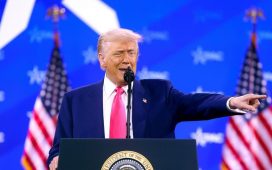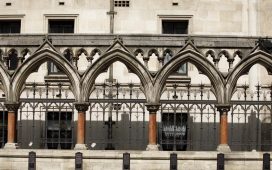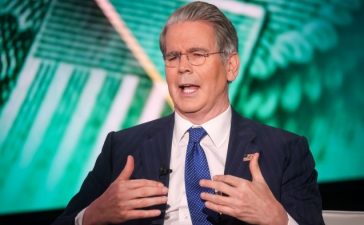The US supreme court is poised to deliver a raft of politically sensitive decisions as it ends its judicial term, addressing tumultuous issues including whether Donald Trump can be prosecuted for his role in the January 6 insurrection in 2021, abortion access for millions of women and the basic functioning of the federal government.
With the court entering its traditional June climax, observers are bracing themselves for yet another potentially seismic four weeks that could radically reshape American public life. Matters before the court include a possible loosening of gun laws in a country with already exceptionally lax controls, and new guardrails on how social media platforms deal with misinformation.
This will be the third full year under the new six-to-three supermajority of rightwing justices created by Donald Trump’s three appointments. How the court rules on the biggest cases will help cement its increasingly partisan and extremist reputation, against the backdrop of grating ethical scandals that call into question the justices’ ability to deliver impartial judgments.
Top of the list of white-hot pending decisions are two cases relating to Trump’s federal prosecution. They embroil the supreme court in the presidential election to a greater degree than at any time since Bush v Gore in 2000, which handed the White House to George W Bush.
The justices have already allowed Trump to stay on the ballot by overturning a Colorado ruling that barred him from public office as an insurrectionist under the 14th amendment to the US constitution. Now the court must decide, in Trump v US, whether he can claim absolute presidential immunity from prosecution relating to the federal case in which he is charged with conspiracy to subvert the 2020 election.
Fischer v US concerns whether rioters at the US Capitol on 6 January 2021 can be charged under an obstruction statute. Should the justices rule against the use of that provision, as they indicated they would in oral arguments, two of the four criminal charges facing Trump in the January 6 prosecution would fall.
“This court has been called by some an imperial court that’s willing to be brave in how it revisits precedent,” said Olatunde Johnson, a law professor at Columbia University, in New York. “If the court issues an expansive ruling on immunity for a former president, that will raise questions about partisanship and ideology, and certainly influence the election.”
The court’s actions have been complicated by the recent revelations from the New York Times that an upside-down flag seen as a symbol of Trump’s “stop the steal” conspiracy to overturn his 2020 defeat was flown at the Virginia home of rightwing justice Samuel Alito at the time of the Capitol insurrection. A second flag, also associated with the riot, was later flown at Alito and his wife’s beach house in New Jersey.
“It raises the question of whether Alito should have recused himself from these cases, and should still recuse himself from the ultimate decisions,” Johnson said. On Wednesday, Alito wrote to Democratic leaders in Congress declining to recuse himself.
A less “imperial” court might think that being thrown into the thick of the presidential election was quite enough judicial conflict for one year. Not this court.
The justices are also set to deliver opinions on the first abortion cases to reach them since they overturned the constitutional right to a termination in the Dobbs case two years ago, scrapping Roe v Wade. They are considering a challenge over access to mifepristone, an abortion pill that is now used in more than 60% of US abortions.
Should the court side with the anti-abortion groups bringing the claim, some 57 million women of reproductive age living in states that allow abortions could be affected. Restrictions would also be further tightened for millions more women in states where abortion bans are already in place.
A second case, Idaho v US, explores the clash between that state’s strict abortion ban and the federal law known as Emtala (Emergency Medical Treatment & Labor Act), which obliges hospitals in receipt of federal funding to give patients emergency medical treatment, including abortions. The stakes here are also immense, as can be seen in Idaho, where the supreme court has allowed the ban to stand while it deliberates.
“There are horror stories of pregnant patients who have suffered horrible medical consequences such as unnecessary hysterectomies because they could not get emergency medical care under the state’s abortion ban,” said Maya Manian, a law professor and authority on reproductive rights at American University Washington College of Law.
For Manian, the confluence of the pair of abortion cases underlines two critical truths: that the anti-abortion movement will not stop until it has achieved a total abortion ban nationwide, and that by tearing up the right to an abortion, the supreme court has created a legal mess that is likely to dog it for years to come.
The court has also intervened in an area of settled law that for 40 years has ensured the smooth and effective operation of federal agencies. Since 1984, the courts have abided by the so-called Chevron doctrine, a principle introduced by the supreme court itself which says that judges should defer to the expertise of federal regulators when they reasonably interpret ambiguous statutes.
Such deference has been critical to the way that the federal government operates in core areas of public life, such as combatting the climate crisis or protecting labor rights.
after newsletter promotion
Rightwing justices indicated in oral arguments that they will ditch Chevron, and with it curtail the regulatory powers of the administrative state. “It would be the final nail in the coffin, weakening the ability of federal agencies to regulate over major areas,” Johnson said.
In any normal year, before any normal supreme court, the other cases that are pending in June would stand out in blazing headlines. As it is, they appear overshadowed.
Take the two cases relating to gun laws. It is testament to how far the rightwing supermajority has already torn down America’s minimal gun controls that US v Rahimi is even being heard.
It concerns a challenge to an existing ban on firearms being possessed by those under domestic violence restraining orders. The individual bringing the case is a drug dealer who was placed under such an order after he abused his girlfriend in a parking lot, then shot at a bystander.
The justices have signaled that they are minded to let the domestic violence ban remain in place. But they were divided on the second gun case, which questions whether the Trump administration acted lawfully in banning so-called bump stocks – gadgets that allow semi-automatic rifles to fire almost as quickly as machine guns, at a rate of hundreds of rounds per minute.
The ban was introduced following the Las Vegas massacre in 2017, when a man opened fire at a country music festival, killing 60 people.
Social media is also on the docket as the court enters its end of term. No fewer than five cases came before the justices in three separate hearings, all within the same general territory of the collision between the first amendment right to free speech and the responsibility of social media companies and public officials in policing misinformation.
One of the cases has already been decided, with the court ruling that public officials can be sued for blocking their critics on social media, but only where the criticism relates to their official duties and not to their personal lives.
Two other big areas remain to be decided that could profoundly affect the way social media companies operate. The justices are wrestling with whether states should be able to proscribe the editorial decisions of those businesses when they moderate content or remove users from their sites.
The case arose after Republican lawmakers in Florida and Texas imposed restrictions on social media companies on how they moderated content after Trump was taken off Facebook in response to his actions relating to the 6 January 2021 attack on the US Capitol. The court is also pondering a move by Republican states, led by Louisiana and Missouri, to prevent the Biden administration from pressuring social media companies to remove misleading information from their platforms on subjects such as Covid and the 2020 election.
Rulings in these cases are likely to set parameters for the foreseeable future on how social media approaches the vexing question of where free speech ends and dangerous misinformation begins.









